3-Epicorosolic acid
3-Epicorosolic acid has a potent inhibitory effect on Epstein-Barr virus early antigen (EBV-EA) induction, it has potential anti-inflammatory activities as well as cancer chemopreventive activity.3-Epicorosolic acid shows both potent α-glucosidase and protein tyrosine phosphatase 1B (PTP1B) inhibitory activities with IC50 values of 30.18 and 4.08 μg/ml respectively.
Inquire / Order:
manager@chemfaces.com
Technical Inquiries:
service@chemfaces.com
Tel:
+86-27-84237783
Fax:
+86-27-84254680
Address:
1 Building, No. 83, CheCheng Rd., Wuhan Economic and Technological Development Zone, Wuhan, Hubei 430056, PRC
Providing storage is as stated on the product vial and the vial is kept tightly sealed, the product can be stored for up to
24 months(2-8C).
Wherever possible, you should prepare and use solutions on the same day. However, if you need to make up stock solutions in advance, we recommend that you store the solution as aliquots in tightly sealed vials at -20C. Generally, these will be useable for up to two weeks. Before use, and prior to opening the vial we recommend that you allow your product to equilibrate to room temperature for at least 1 hour.
Need more advice on solubility, usage and handling? Please email to: service@chemfaces.com
The packaging of the product may have turned upside down during transportation, resulting in the natural compounds adhering to the neck or cap of the vial. take the vial out of its packaging and gently shake to let the compounds fall to the bottom of the vial. for liquid products, centrifuge at 200-500 RPM to gather the liquid at the bottom of the vial. try to avoid loss or contamination during handling.
Molecules.2020, 25(9):2111.
Food Chem.2024, 436:137768.
Molecules2022, 27(12):3903.
Research on Crops.2017, 18(2)
J Agric Food Chem.2021, 69(46):14037-14047.
Nat Commun.2024, 15(1):8221.
Int J Oncol.2019, 55(1):320-330
International Food Research Journal2018, 25(6):2560-2571
TCI CO.2019, US20190151257A1
Nanotechnology.2024, ad470d.
Related and Featured Products
Biosci Biotechnol Biochem. 2004 Jan;68(1):85-90.
Triterpene acids from the leaves of Perilla frutescens and their anti-inflammatory and antitumor-promoting effects.[Pubmed:
14745168]
METHODS AND RESULTS:
Nine triterpene acids, viz., six of the ursane type, ursolic acid (1), corosolic acid (2), 3-Epicorosolic acid (3), pomolic acid (4), tormentic acid (5) and hyptadienic acid (6), and three of the oleanane type, oleanolic acid (7), augustic acid (8) and 3-epimaslinic acid (9), among which 1 constituted the most predominant triterpene acid, were isolated and identified from ethanol extracts of the leaves of red perilla [Perilla frutescens (L.) Britton var. acuta Kudo] and green perilla [P. frutescens (L.) Britton var. acuta Kudo forma viridis Makino]. These eight compounds, 1, 2, 4-9, were evaluated for their inhibitory effects on 12-O-tetradecanoylphorbol-13-acetate (TPA)-induced inflammation (1 microg/ear) in mice.
CONCLUSIONS:
All the compounds tested showed a marked anti-inflammatory effect, with a 50% inhibitory dose (ID50) of 0.09-0.3 mg per ear. In addition, an evaluation against the Epstein-Barr virus early antigen (EBV-EA) activation induced by TPA showed five compounds, 1-3, 5 and 9, with a potent inhibitory effect on EBV-EA induction (91-93% inhibition at 1x10(3) mol ratio/TPA). Furthermore, compound 5 exhibited strong antitumor-promoting activity in an in vivo two-stage carcinogenesis test of mouse tumor by using 7,12-dimethylbenz(a)anthracene (DMBA) as an initiator and TPA as a promoter.
Bioorg Med Chem Lett. 2015 Oct 1;25(19):4342-6.
Synthesis of oxygenated oleanolic and ursolic acid derivatives with anti-inflammatory properties.[Pubmed:
26259803]
METHODS AND RESULTS:
The scalable syntheses of four oxygenated triterpenes have been implemented to access substantial quantities of maslinic acid, 3-epimaslinic acid, corosolic acid, and 3-Epicorosolic acid. Semi-syntheses proceed starting from the natural products oleanolic acid and ursolic acid. Proceeding over five steps, each of the four compounds can be synthesized on the gram scale. Divergent diastereoselective reductions of α-hydroxy ketones provided access to the four targeted diol containing compounds from two precursors of the oleanane or ursane lineage. These compounds were subsequently evaluated for their ability to inhibit inflammatory gene expression in a mouse model of chemically induced skin inflammation.
CONCLUSIONS:
All compounds possessed the ability to inhibit the expression of one or more inflammatory genes induced by 12-O-tetradecanoylphorbol-13 acetate in mouse skin, however, three of the compounds, corosolic acid, 3-Epicorosolic acid and maslinic acid were more effective than the others. The availability of gram quantities will allow further testing of these compounds for potential anti-inflammatory activities as well as cancer chemopreventive activity.
Res Pharm Sci. 2014 Jan-Feb;9(1):11-22.
In vitro antidiabetic potential of the fruits of Crataegus pinnatifida.[Pubmed:
25598795]
In an attempt to develop alternative medicine for the treatment of diabetes and related complications, the antidiabetic potential of the fruits of Crataegus pinnatifida was evaluated.
METHODS AND RESULTS:
The antidiabetic potential of the methanol (MeOH) extract as well as different solvent soluble fractions of the fruits of C. pinnatifida was evaluated via α-glucosidase, protein tyrosine phosphatase 1B (PTP1B), rat lens aldose reductase (RLAR), and advanced glycation end products (AGEs) formation inhibitory assays. The MeOH extract showed potent inhibitory activity against α-glucosidase, PTP1B, and AGEs formation with IC50 values of 122.11, 3.66 and 65.83 μg/ml respectively, while it showed moderate inhibitory activity against RLAR with the IC50 value of 160.54 μg/ml. Among different fractions, the ethyl acetate (EtOAc) and the dichloromethane (CH2Cl2) fractions were found as active fractions exhibiting potential α-glucosidase, PTP1B, RLAR inhibitory, and AGEs formation inhibitory activities. Seven compounds including hyperoside, chlorogenic acid, ursolic acid, oleanolic acid, 3-Epicorosolic acid, β-sitosterol, β-sitosterol glucoside were isolated from these two fractions. 3-Epicorosolic acid showed both potent α-glucosidase and PTP1B inhibitory activities with IC50 values of 30.18 and 4.08 μg/ml respectively. Moreover, kinetic study revealed that 3-Epicorosolic acid showed mixed type inhibition against PTP1B, while it showed uncompetitive inhibition against α-glucosidase.
CONCLUSIONS:
Therefore, these results suggest that the fruits of C. pinnatifida and its constituents have potential antidiabetic activity which might be used as a functional food for the treatment of diabetes and associated complications.



